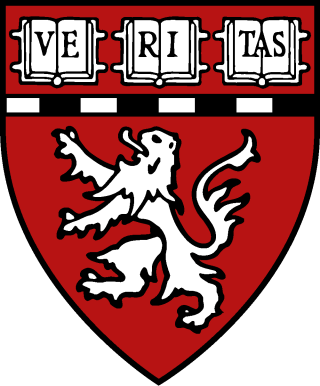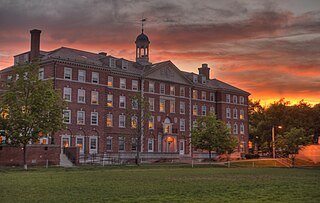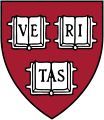
Heraldry is a discipline relating to the design, display and study of armorial bearings, as well as related disciplines, such as vexillology, together with the study of ceremony, rank and pedigree. Armory, the best-known branch of heraldry, concerns the design and transmission of the heraldic achievement. The achievement, or armorial bearings usually includes a coat of arms on a shield, helmet and crest, together with any accompanying devices, such as supporters, badges, heraldic banners and mottoes.

Harvard Law School (HLS) is the law school of Harvard University, a private research university in Cambridge, Massachusetts. Founded in 1817, Harvard Law School is the oldest continuously operating law school in the United States.

Charles William Eliot was an American academic who was president of Harvard University from 1869 to 1909, the longest term of any Harvard president. A member of the prominent Eliot family of Boston, he transformed Harvard from a respected provincial college into America's preeminent research university. Theodore Roosevelt called him "the only man in the world I envy."

In heraldry, a compartment is a design placed under the shield, usually rocks, a grassy mount, or some sort of other landscape upon which the supporters are depicted as standing. Care must be taken to distinguish true compartments from items upon which supporters are merely resting one or more feet, or, sometimes, mere heraldic badges or pure decoration under the shield, and, conversely, care must also be taken in very unusual cases such as the coat of arms of Belize and Gabon, in which what may be taken to be a crest, trees in both coats of arms rising above the shield, is really part of the compartment. It is sometimes said to represent the land held by the bearer. As an official part of the blazon it is a comparatively late feature of heraldry, often derived from the need to have different supporters for different families or entities, although sometimes the compartment is treated in the blazon separately from the supporters.

Harvard College is the undergraduate college of Harvard University, a private Ivy League research university in Cambridge, Massachusetts, United States. Part of the Faculty of Arts and Sciences, Harvard College is Harvard University's traditional undergraduate program, offering AB and SB degrees. It is highly selective, with fewer than four percent of applicants being offered admission as of 2022.

Samuel Eliot Morison was an American historian noted for his works of maritime history and American history that were both authoritative and popular. He received his Ph.D. from Harvard University in 1912, and taught history at the university for 40 years. He won Pulitzer Prizes for Admiral of the Ocean Sea (1942), a biography of Christopher Columbus, and John Paul Jones: A Sailor's Biography (1959). In 1942, he was commissioned to write a history of United States naval operations in World War II, which was published in 15 volumes between 1947 and 1962. Morison wrote the popular Oxford History of the American People (1965), and co-authored the classic textbook The Growth of the American Republic (1930) with Henry Steele Commager.

Harvard Medical School (HMS) is the medical school of Harvard University and is located in the Longwood Medical Area in Boston, Massachusetts. Founded in 1782, HMS is one of the oldest medical schools in the United States. Harvard Medical School (HMS) provides patient care, medical education, and research training through its 15 clinical affiliates and research institutes such as Massachusetts General Hospital (MGH), Dana–Farber Cancer Institute, Brigham and Women's Hospital, Beth Israel Deaconess Medical Center, Boston Children's Hospital, McLean Hospital, Cambridge Health Alliance, The Baker Center for Children and Families, and Spaulding Rehabilitation Hospital. Harvard Medical School also partners with newer entities such as Harvard Catalyst, Broad Institute of MIT and Harvard, Harvard Stem Cell Institute, the Center for Primary Care, and Wyss Institute for Biologically Inspired Engineering.

The White Rose of York is a white heraldic rose which was adopted in the 14th century as a heraldic badge of the royal House of York. In modern times, it is used more broadly as a symbol of Yorkshire.

The president of Harvard University is the chief administrator of Harvard University and the ex officio president of the Harvard Corporation. Each is appointed by and is responsible to the other members of that body, who delegate to the president the day-to-day running of the university.

Cabot House is one of twelve undergraduate residential Houses at Harvard University. Cabot House derives from the merger in 1970 of Radcliffe College's South and East House, which took the name South House, until the name was changed and the House reincorporated in 1984 to honor Harvard benefactors Thomas Cabot and Virginia Cabot. The house is composed of six buildings surrounding Radcliffe Quadrangle; in order of construction, they are Bertram Hall (1901), Eliot Hall (1906), Whitman Hall (1911), Barnard Hall (1912), Briggs Hall (1923), and Cabot Hall (1937). All six of these structures were originally women-only Radcliffe College dormitories until they were integrated in 1970. Along with Currier House and Pforzheimer House, Cabot is part of the Radcliffe Quad.

The history of Harvard University begins in 1636, when Harvard College was founded in the young settlement of New Towne in Massachusetts, which had been settled in 1630. New Towne was organized as a town on the founding of the university, and changed its name two years later to Cambridge, Massachusetts, in honor of the city in England. It is the oldest institution of higher learning in the United States.

Heraldry in the United States was first established by European settlers who brought with them the heraldic customs of their respective countries of origin. As the use of coats of arms may be seen as a custom of royalty and nobility, it had been debated whether the use of arms is reconcilable with American republican traditions. Families from English, Scottish, Irish, Welsh, German, and other European nations with a heraldic tradition have retained their familial coat of arms in the United States. Several founding fathers also employed personal arms and a great number of Americans continue to do so.

Harvard University is a private Ivy League research university in Cambridge, Massachusetts. Founded in 1636 as Harvard College and named for its first benefactor, Puritan clergyman John Harvard, it is the oldest institution of higher learning in the United States. Its influence, wealth, and rankings have made it one of the most prestigious universities in the world.
Pierre de Chaignon la Rose was an American heraldist and heraldic artist.

The Samuel Eliot Morison bibliography contains a list of books and articles written by American historian Samuel Eliot Morison.

What was originally called Harvard Colledge (around which Harvard University eventually grew) held its first Commencement in September 1642, when nine degrees were conferred. Today some 1700 undergraduate degrees, and 5000 advanced degrees from the university's various graduate and professional schools, are conferred each Commencement Day.

The Brown University coat of arms is the assumed heraldic achievement of Brown University. The achievement in its current iteration was adopted in 1834.

Heraldry is the system of visual identification of rank and pedigree which developed in the European High Middle Ages, closely associated with the courtly culture of chivalry, Latin Christianity, the Crusades, feudal aristocracy, and monarchy of the time. Heraldic tradition fully developed in the 13th century, and it flourished and developed further during the Late Middle Ages and the Early Modern period. Originally limited to nobility, heraldry is adopted by wealthy commoners in the Late Middle Ages. Specific traditions of Ecclesiastical heraldry also develop in the late medieval period. Coats of arms of noble families, often after their extinction, becomes attached to the territories they used to own, giving rise to municipal coats of arms by the 16th century.

The coat of arms of the University of Notre Dame is the assumed heraldic achievement of the University of Notre Dame. It was designed by noted American heraldist Pierre de Chaignon la Rose in 1931.

The coat of arms of the University of Pennsylvania is the assumed heraldic achievement of the University of Pennsylvania. The achievement in its current iteration was approved in 1932 and adopted in 1933. The blazon of the achievement is
Arms: In the chief, gules, two open books and a dolphin, argent; in the ground, argent, a chevron, azure, with three plates, argent. Motto: Quid leges sine moribus vanae proficiunt.



























































